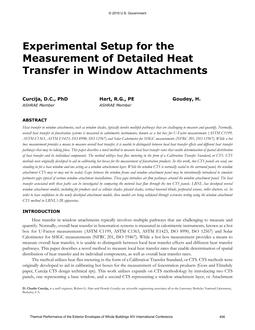Click here to purchase
Heat transfer in window attachments, such as window shades, typically involve multiple pathways that are challenging to measure and quantify. Normally, overall heat transfer in fenestration systems is measured in calorimetric instruments, known as a hot box for U-Factor measurements (ASTM C1199, ASTM C1363, ASTM E1423, ISO 8990, ISO 12567) and Solar Calorimeter for SHGC measurements (NFRC 201, ISO 12567). While a hot box measurement provides a means to measure overall heat transfer, it is unable to distinguish between local heat transfer effects and different heat transfer pathways that may be taking place. This paper describes a novel method to measure local heat transfer rates that enable determination of spatial distribution of heat transfer and its individual components. The method utilizes heat flux metering in the form of a Calibration Transfer Standard, or CTS. CTS methods were originally developed to aid in calibrating hot boxes for the measurement of fenestration products. In this work, two CTS panels are used, one standing in for a base window and one acting as a window attachement layer. While the window CTS is normally sealed to the surround panel, the window attachment CTS may or may not be sealed. Gaps between the window frame and window attachment panel may be intentionally introduced to simulate perimeter gaps typical of various window attachment inatallations. These gaps introduce air flow pathways around the window attachment panel. The heat transfer associated with these paths can be investigated by comparing the metered heat flow through the two CTS panels. LBNL has developed several window attachment models, including for products such as cellular shades, pleated shades, vertical louvered blinds, perforated screens, roller shutters, etc. In order to have confidence in the newly developed attachment models, these models are being validated through extensive testing using the window attachment CTS method in LBNL’s IR apparatus.
Citation: Thermal Buildings XIV 2019
Product Details
- Published:
- 2019
- Number of Pages:
- 12
- Units of Measure:
- Dual
- File Size:
- 1 file , 2.2 MB
- Product Code(s):
- D-Bldgs19-050
